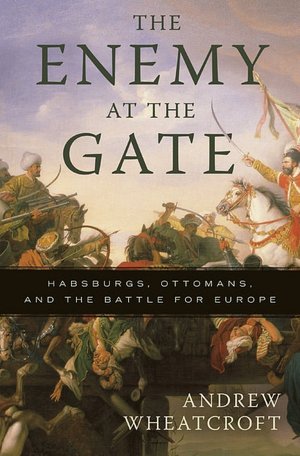Andrew Wheatcroft, in his book, The Enemy at the Gate: Habsburgs, Ottomans, and the Battle for Europe, tells a story of centuries of relations between a Western, Christian empire and an Oriental, Muslim empire. The book focuses on warfare.
The central piece is the siege of Vienna. The Ottoman troops marched a thousand miles from their base to lay siege to the capital of the Habsburg empire and due to the logistical superiority of the Ottomans almost succeeded in capturing Vienna. The core of the Ottoman force were well trained professional infantry and cavalry, supported by Tartar irregular cavalry, artillery and a strong engineering core (which could build roads, bridge rivers, and destroy fortifications), supported by irregular troops raised from a feudal system.
Encouraged by the success of a last minute rescue of the city by a multinational force, the Habsburgs were fortunate in the arrival of a highly capable military leader, and reformed their logistics and training to develop an effective military that eventually conquered Budapest and regained Hungary for the empire.
It is not clear that there was any greater animosity between the Habsburg Catholic empire and the Ottoman Muslim empire than there was between Catholic and Protestant nations in Europe, and indeed the military progress gained by the Habsburgs in fighting wars against Protestants was an important factor in the improvement of the Habsburg chances against the Ottomans, who were similarly at war with other Muslim forces on their eastern borders.
On the other hand, the book suggests that religious zeal was a powerful motivational factor for the troops themselves; it also suggests that they demanded money to fight. The hand to hand fighting that did occur from time to time during pitched battles and sieges must have been truly terrible.
Wheatcroft concludes his history with a consideration of how the imperial powers replaced historical events with myths that supported the status of their imperial monarchs. This seems to me typical of monarchs over time. (I note how the Windsors are seeking to create their own myth, and if Wheatcroft is right that such behavior marks the decline of empire, that bodes badly for the Queen's descendants.) Indeed, the presidential candidates in our current election are trying hard to create myths of their suitability for the head of the U.S. government. (Recall that 150 conservative evangelical leaders endorsed Rick Santorum before the South Carolina primary, suggesting that religious aspects to the myth of presidential qualification remain even in our republic which in theory separates church and state.)
Wheatcroft notes how the old myths seem to have a new life in Western Europe which is seeing immigration of Muslims and a bid for membership in the European Union. From this side of the pond, fear and prejudice against Muslim immigrants to Europe seems a lot like the fear and prejudice against Hispanic immigrants to the United States today, or against the European and Asian immigrants to the United States in the 19th century. The mythical reasons for the antagonism may be different, but both probably are based on human nature.
I suggest that one of the functions of history is to challenge the destructive aspects of our myths with fact and new interpretations. Perhaps the public intellectual should help to build new myths which help us to behave more humanely. Washington may not have confessed to his father that he cut down the cherry tree, but generations of kids were encouraged toward honesty by the myth!

No comments:
Post a Comment